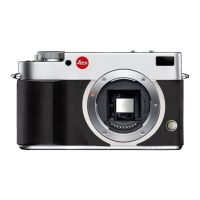2
[MODE3] has been added to [OIS MODE] on the menu for taking pictures.
• It is more difficult to achieve the effects of panning in the following situations:
• In brightly lit places such as in broad daylight on a summer’s day
• When the shutter speed is faster than 1/100
s
• When the subject is moving slowly and the speed at which the camera is turned is too slow (to make it
look like the background is flowing by)
• When the camera cannot track the movements of the subject closely
• It is recommended that you take pictures using the viewfinder.
In addition to the high-angle mode that makes it easier to see what is on the LCD monitor screen
when taking pictures from high positions, there is now also a new low-angle mode that similarly
makes it easier to see what is on the LCD monitor screen when taking pictures from low positions.
1Keep [DISPLAY] pressed for one second.
A: [DISPLAY] button
B: LCD monitor
2 Select the mode using the command dial ( ) or 3/4.
3 Press the shutter button halfway to enter the setting.
• The setting can also be entered by pressing [MENU/SET].
: High-angle mode
: Low-angle mode
To cancel the high-angle mode or low-angle mode
Keep [DISPLAY] pressed again for one second. This causes the screen in step 2 to be displayed.
Now select the [OFF] setting to cancel the high-angle mode or low-angle mode.
• The high-angle mode or low-angle mode is cancelled when the power is turned off (including power save
mode).
• In the high-angle mode or low-angle mode, the brightness of the image displayed on the LCD monitor is
adjusted. Depending on the subject, the image may appear to be somewhat different
than in reality, but the
image recorded remains unaffected.
• When sunlight or other strong light is reflected by the LCD monitor so that it is hard to see what is on the
screen, you might not be able t
o judge the effect of the high-angle mode or low-angle mode. In such cases
it is recommended that y
ou shade out the light with your hand to use the mode.
• The high-angle mode or low-angle mode will not work in the following situations:
• In the playback mode
• While menu screens are displayed
[MODE3] (panning mode) has been incorporated for image stabilization
(camera shake correction).
Item Effect
[MODE1]
()
Camera shake is corrected at all times in the mode for taking pictures. It enables you to take
pictures with stability after deciding on the composition using the telephoto function.
[MODE2]
()
Camera shake is corrected when the shutter button is pressed. The resulting correction is more
effective.
[MODE3]
()
Camera shake is corrected
only for vertical movements. This mode is
ideal for panning (a method of taking pictures which involves
following a
continually moving subject (from left to right or vice versa) with the camera
to create a dynamic effect).
A low-angle mode that makes it easier to see what is on the LCD monitor
during Live View picture-taking at a low angle has been incorporated.
ISOISO
100100
P
STDSTD
1919
OFFOFF
Item Description of setting
:
High angle
This makes it easier to see what is on the LCD monitor screen when taking pictures
from high positions. It comes in handy when there are people in front of you and you
cannot get close to the subject. (In this mode, however, it is hard to see what is on the
display if you look at it straight on.)
:
Low angle
This makes it easier to see what is on the LCD monitor screen when taking pictures
from low positions. It comes in handy when taking pictures of flowers that are
blossoming close to the ground or taking pictures at the eye level of children or pets. (In
this mode, however, it is hard to see what is on the display if you look at it straight on.)
[OFF] This returns the LCD monitor screen to its normal brightness.
ISOISO
100100
P
STDSTD
1919
B
A

